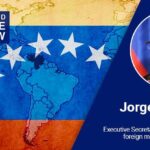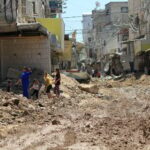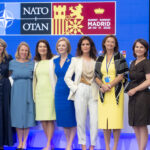
By Oliver Boyd-Barrett – Jul 13, 2021
The only character who actually dies in Disney’s Cruella is the sweet, good servant, Catherine, who consents to raise Cruella – condemned to death by her birth mother, the grotesquely unfeeling Baroness De Vil – as her own daughter. Cruella and the Baroness shall dance a burlesque that plays out to the morbid rhythm of an eternal melody. Similarly in Peru since even the time of Spanish dominion a macabre masquerade has been enacted between conservatives and liberals, parties born of the same mother, Empire, whose local nemesis, Pachamama, struggles vainly with these uninvited adoptees in the face of their mutual despoliation of the natural order. Pachamama and her birth children, the Indigenous, do not fare well in this movie.
Vargas Llosa Musings
Peru’s – and perhaps the world’s – greatest living and truly genius novelist, 2010 winner of the Nobel Prize in Literature, Mario Vargas Llosa, and unequalled expert on the psychology of Latin American caudillos, is himself the progeny of Peru’s deepest contradictions. In any other context it would be difficult to conceive how the celebrator of anarchy in Le Guerra del Fin del Mundo could possibly condemn Pedro Castillo, whom progressives must continue to hope will be inaugurated as president of Peru on July 28, as a presage of dictatorship and backwardness. To deepen his wound, Vargas Llosa, who campaigned for the presidency in 1990 against Alberto Fujimori, has expressed his preference for Cruella (or, perhaps, the Baroness) herself, Keiko Fujimori, Alberto’s eldest daughter.
Her father dissolved the Peruvian Congress in 1992, setting himself up as dictator for the next eight years, and whose enforcer was intelligence chief, Vladimiro Montesinos, with the help of $10 million from the CIA with whom Montesinos had a long-standing relationship. The CIA financed an anti-narcotics unit organized by Montesinos in the National Intelligence Service (SIN), despite reports of the involvement by Fujimori’s eminence grise in corruption, drug trafficking and human rights violations. A powerful Peruvian drug lord of the 1990s, Demetrio Chávez, testified in court that he paid US$50,000 monthly in bribes to Montesinos and several army officers.
Aged 19 in 1994, Keiko, who appears to have specialized more than anything else in the fine art of losing three presidential elections, accepted the title of First Lady from her father. Alberto had booted out (and was eventually to divorce) his much-abused wife, Susana, after Susana had accused him both publicly and in court, of kidnapping, torture, and corruption, and sought to run against him in the 1995 elections (Alberto changed the law so that Susana could not qualify).
Comparable perhaps to the bestowal on Keiko of the title of First Lady, Vargas Llosa, who replaced his own wife of 50 years in 2016 in favor of the 64-year-old mother of Enrique Iglesias – dubbed the ‘Pearl of Manila’ by the Daily Mail – was willing recipient of the hereditary title of 1st Marquis in the peerage of Spain, granted him in 2011 by the King of Spain, Juan Carlos I, the monarch who was soon to abdicate in disgrace for financial and other improprieties.
Meditations on Andean Peasantry
In his novel Lituma en los Andes (1993) Vargas Llosa turned his attention to the Andean Indigenous at the peak of the Maoist-inspired, rural, terrorist movement Sendero Luminoso. He peered deep into a primeval blackness belied by the peasantry’s colorful alpaca hats, facemasks, and ponchos. His niece, the film director Claudia Llosa, achieves much the same effect in her anthropological dissection of Andean village culture in Madeinusa (2006) and La Teta Asustada (2009). In his more recent Tiempos Recios (2019) Vargas Llosa constructs an allegory of the Fujimori and Montesinos years – a sort of lament, perhaps, for his own failure to out beat Fujimori electorally in 1990, and in which politically naïve, fearful members of Lima’s wealthy technocracy are represented as vain and foolish. Nor should we forget that in his novel El Sueño del Celta (2010) Vargas Llosa had already painted as horrific a picture of the abuse and slaughter of Amazonian Indigenous by European rubber interests around the turn of the twentieth century as has ever been accomplished.
It is not the Indigenous to whom we should first look for evidence of primeval blackness, but to the Conquistadores, their armies, priests, and traders whose swirling, mendacious blackness of racism, violence, and greed, conjoined
Which leads us, then, to wonder at Vargas Llosa’s monumental failure of political judgment when confronted with a choice between Keiko Fujimori and Pedro Castillo. For it is not the Indigenous to whom we should first look for evidence of primeval blackness, but to the Conquistadores, their armies, priests, and traders whose swirling, mendacious blackness of racism, violence, and greed, conjoined with equally toxic liquids from the north, saturates beyond repair the entire continent of Latin America to this day. Vargas Llosa projects his attention outwards when he should be looking inwards: he has reversed cause and effect, abuser and victim.
It is not the Indigenous who are dark and mysterious. More likely they are tired, and they are angry. They are tired of providing pretty pictures for frivolous tourists whose travel to Peru from countries far wealthier than theirs contributes to planetary destruction, and whose corporations seize 70% of the profits earned by exploitation of the country’s mineral resources on Indigenous land. Peru has the world’s biggest reserves of silver, as well as Latin America’s largest reserves of gold, lead and zinc. The Peruvian coast is renowned for its marine resources. The Amazon basin possesses large reserves of oil and natural gas, as well as abundant forestry resources.
Winner of the 2021 presidential election Pedro Castillo, explained:
“Peru is such a wealthy country but so much of the wealth, such as copper, gold, and silver, goes to foreigners. At the ports, you see an endless stream of trucks taking away the resources of the country and just two hundred meters away, you see a barefoot child, a child with tuberculosis, a child full of parasites. That is why we must renegotiate the contracts with big companies so that more of the profits remain in Peru and benefit the people. We must reexamine the free trade agreements we have signed with other countries so that we can promote local businesses”.

But what are the prospects for real change? In what follows I shall look at how Peru’s natural wealth and indigenous people interact with Cruella’s Hispanic Dance of the Macabre, starting with its latest episode (Pedro vs. Keiko) then retreating to the Spanish conquest, before moving to mid-19th century reinterpretations of Cruella’s dance that sought to integrate the Indigenous, on more harmonious grounds, and finally pausing at Peru’s nearest shot at authentic revolution, the Velasco regime, and its morbid neoliberal Fujimori aftermath.
The Policies and Politics of Pedro Castillo
Presidential candidate Pedro Castillo won the 2021 presidential election by a margin of 44,000 votes on the second round, with 50.14% of the votes counted as against Keiko Fujimori who garnered 49,86%. If the election is validated, then President Castillo will command 42 out of the 130 seats in Congress, whilst Fujimori’s Fuerza Popular and the other right wing electoral coalitions will have a combined parliamentary strength of at least 80 seats. If the election is not validated and no president is inaugurated on July 28, then under the constitution there must be new elections.
The 2021 presidential election in Peru should have ended several weeks ago, at the time of this writing, but validation of Castillo as president has been delayed by Fujimori´s denunciations sin evidencia, and in the style of Trump – yet afforded legitimacy by representations of some military and conservative figures through their own media (more than 70% of Peru’s news is owned and controlled by El Comercio Group which among other things propagates Fujimori’s ridiculous assertion that Castillo is a Sendero Luminoso communist). This might seem less outrageous in the capital, Lima, where Fujimori support is concentrated and where major corporations have threatened their employees with the loss of their jobs if they failed to vote for Fujimori. A highly suspicious massacre of 16 people in San Miguel del Ene on May 23rd, attributed by police to an unlikely, mysteriously reborn Sendero movement, was more likely to have been a ghastly pro-Fujimori terror campaign.
Those who supported Keiko Fujimori’s claim that the election had been stolen and that 200,000 votes should be thrown out were concentrated in the upper classes of the capital, Lima, and included former military leaders and members of influential families. Some openly called for a new election, or even a military coup if Mr. Castillo was sworn in. Hundreds of retired military officers sent a letter to top military chiefs urging them to not recognize “an illegitimate president.” A former Supreme Court justice filed a lawsuit requesting that the entire election be annulled. The Defense Ministry has confirmed that Alberto Fujimori’s henchman, Vladimiro Montesinos, in jail on a naval facility, was somehow able to use a landline number to make 17 phone calls to Pedro Rejas, a retired military officer and formerly loyal Fujimori cohort who later revealed the recordings. In one conversation Montesinos appeared to suggest that bribes be paid through an intermediary to three of the four members of an electoral tribunal to favor Fujimori in a recount.
On July 3, Peru’s government rejected Fujimori’s request to seek an international audit of its June 6 election. Even the U.S. State Department had described the election as a model of democracy. International observers, including the Organization of American States (OAS), found no evidence of major irregularities. Both the USA and EU praised the electoral process. Michelle Bachelet, the former Chilean president, the United Nations high commissioner for human rights, urged Peruvians to accept the election results. The National Elections Jury charged with reviewing contested ballots should have completed its task by mid-July so that a new president can be sworn in on July 28th. Its work was held up by a week after one of the judges resigned (he has been replaced).
A writer for theFinancial Times has described Pedro Castillo, 51 years old, as a rural primary school teacher, a son of peasant farmers, and trade union activist. Castillo recently elaborated:
“This year we are celebrating the bicentennial of Peru as a republic, yet after two hundred years, we still have a high level of illiteracy, and the homes of my parents and neighbors don’t have electricity, lights, or running water. There’s a totally abandoned health center where once in a while a nurse comes by and maybe you can find a bandage or a few pills for all the families. As I traveled in rural areas across the country, I found conditions similar to my hometown. Further into the Amazon, conditions are even worse. People there have nothing; they are totally abandoned by the state”.
From 2005 to 2017 Castillo was affiliated with Perú Posible, a centrist party led by former president Alejandro Toledo. In 2017, the year he attained prominence as a leading figure in the 2017 teacher strike in Peru, Castillo joined his current party, Partido Nacional PERÚ LIBRE (PNPL) or Perú Libre, which claims a Marxist-Leninist heritage and proposes a left-wing program centered around increased spending on education and health services, nationalization of key extractive sectors, anti-corruption, and salary limits for congressional members.
Castillo was born to two illiterate peasants in one of the poorest regions in Peru. He is the third child of nine in his parents’ family. 60% of Peruvians do not have access to internet, and Castillo did not have a Twitter account. His campaign relied on community radios, personal visits to small towns, and cultural events. He built his presidential election campaign around resource nationalism and Indigenous rights. A central tenet of his PERÚ LIBRE party is to restructure Peru as a plurinational state along the basic lines of Ecuador and Bolivia. Peru has 4 major indigenous languages in the Andes (Quechua, Aymara, Cauqui and Jaqaru) and 43 more in the Amazon region.

Castillo has plans to rewrite the Constitution to give the state a greater role in the economy and keep a larger share of profits from mineral resources. Amid uncertainty over the final electoral outcome, he appointed more moderate economic advisers and sought to retain central bank head Julio Velarde – seen by many as a symbol of stability. The PERÚ LIBREprogram addresses land reform, nationalization of natural resources to ensure that most of this wealth remains in Peru and available for the eradication of poverty, increases in state expenditure on social services (health and education), income redistribution, decriminalization of abortion. Other targets include human trafficking, especially of women; elimination of patriarchy and machismo in state and society; respect and promotion of women’s reproductive rights; and promotion of the self-organization of women at every level. Castillo himself, it should be noted, has reportedly opposed the legalization of abortion, same-sex marriage, and policies promoting gender equality. Additionally, PERÚ LIBRE aims to abandon the OAS (unofficial US regime-change machine) and return to UNASUR. The party strongly supports Cuba and Venezuela.
Although Castillo won only 18% of the vote for PERÚ LIBRE in the first round this was still something of a surprise, since the main contender for the left was thought to have been Veronika Mendoza, candidate of the Juntos por el Peru coalition, who obtained slightly less than 8%. Castillo was one of the least known among eighteen contenders in the first round. 70% of voters did not choose either Pedro Castillo or Keiko Fujimori. Many voters had been convinced by opposition propaganda that Vladimir Cerrón, the Marxist leader of Castillo’s party, Perú Libre, was the real power behind Castillo. It did not help that PERÚ LIBRE, although constituted in part by school union organizers like Castillo, also maintains loose ties to MOVADEF, a political movement that seeks amnesty for convicted terrorists, and advocates political participation and reconciliation between fully rehabilitated former terrorists and the citizenry at large. Castillo is anything but a terrorist. On the contrary, he was a rondero who helped lead peasant civilian militias that were officially recognized by the Peruvian government to defend small towns in the Andes against Sendero Luminoso terrorist cells during the 1980s and early ’90s. But no matter how progressive Castillo’s policies may seem they are also worryingly flexible in the face of potential setbacks and different audiences, and in Peru there is a bad history of the better promises of progressives or of progressive elements of neoliberals heading south (think Alan Garcia or Ollanta Humala) as quickly as champagne bottles at campaign victory fiestas. The show of humble, even Indigenous, origins, offers insufficient protect against such a turn of events.
The Politics and Policies of Keiko Fujimori
Fujimori is clearly a member of the Peruvian elite, albeit one whose father is still doing jail time – as is his former intelligence chief (the two are estimated to have stolen a combined $600 million during their decade in power). In a pre-Trumpian and therefore more rational world she would have stood nowhere near a position of power since prudence dictates even to social elites that they should keep the progeny of corrupt and murderous dictators hidden in the nursery or cellar, figuratively speaking of course. In opinion polls, Fujimori has been among the least popular politicians in Peru. She has candidly supported her father’s dictatorial legacy and defended his record of state-sponsored extra-judicial killings. She has been hailed by the New York Times as a “towering symbol of the Peruvian elite and the heir to a right-wing populist movement started three decades ago by her father, the former President Alberto Fujimori.”
She became First Lady at the age of 19. She attended Stony Brook University in New York and earned a business degree from Boston University in 1997. She obtained her MBA from Columbia University in 2008. Her party, Fuerza Popular, promotes “fujimorism,” advocating for free trade and strong security. In 2016, Keiko Fujimori campaigned for tax breaks, incentives for small businesses to encourage registration of informal companies and allowing (Indigenous) communities to become shareholders in mining projects.
She vowed to expand electricity and internet coverage into rural areas. In 2021 she has vowed to protect the interests of small and medium-sized businesses over large multinationals. She has advocated for state participation in strategic industries such as energy. She has also insisted that large mining projects must have the support of local communities to proceed. In short, she has cleverly hybridized the neoliberal policies of social elites with reassuring noises of concern for the middle classes and Indigenous.
Oliver Boyd-Barrett is Professor Emeritus, Bowling Green State University, Ohio and California State Polytechnic University, Pomona. is recent books include: Media Imperialism (Sage); Western Mainstream Media and the Ukraine Crisis (Routledge); Syrian Conflict Propaganda: Narrative Battles (in press, Routledge). He currently teaches at CSU Channel Islands.
Featured image: File Photo





